
In the River TAKAHARA --Vol.70--
Mayfly and Sedge
It is true that a lot of sedges were flying around the River Takahara but it was a scene after June. Before that time only a few of them were flying at the warm upper reaches. In spring small mayflies were dominant and they became large as summer drew near.When I fished a new place I always tried various methods, learning about the place. In the River Takahara I first tested the mayfly-size fly because somehow the fish often made the rise to mayflies.
During several days just after the opening day I mainly used size 16 dry fly in the daytime and size 14 in the evening. As for wet fly I chose size 12 in the daytime and size 10 in the evening. At first I was satisfied with my choice but as I fished more I changed the fly size and the pattern.
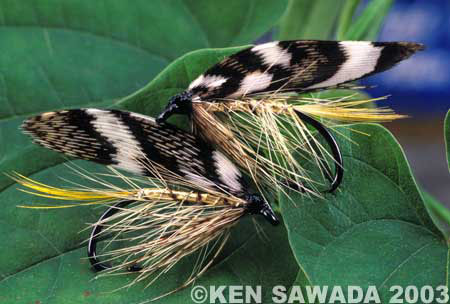
Great Sedge is a born killer fly.
The biggest change was that I used the different flies between the upper and the lower reaches of the River Takahara. It is true that there was almost no difference of water temperature between both areas when the water amount including the snow melting water, which started flowing from the end of April, reached 10 times as much as cold season. But before that time the water was warmer at the upper reaches, where warm water sprung. Actually, in March the upper reaches looked like an early summer river, whereas the lower reaches near Kuzuyama remained a winter river. Therefore different sizes of the aquatic insects were hatched in each area. At the lower reaches a lot of Olives of from size 16 to size 18 were flying down on the snow only in the warm daytime. Then yamame trout and char made rises to those Olives in the daytime.
On the other hand, at the upper reaches of Kansaka, like Karukaya, Chubu Technical College, Yarimi Bridge and the spa of Hida, the water was so much warmer that the situation was quite different. It was like early summer at least under the water. Larger mayflies were hatched and some, even a few, sedges were hatched, too. But once those aquatic insects came out of the water, they were often exposed to snowstorm or the terrible cold of sub-zero degs C even in a fine weather. Then many of them were frozen to death without flying for a moment. It was the same situation as The River Oshino in March.
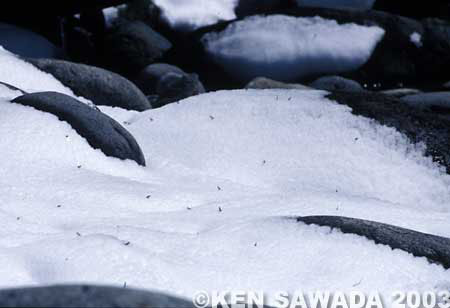
The water temperature was so high that a lot of Olives were hatched even in snow.
That was why my fly choice was gradually changed into big flies at the upper reaches from the opening day. Then the fish responded better than before.
To put it concretely, at the lower reaches in early spring I often used wet flies of Coffee Break, Malloch’s Favourite, Light Cahill, Mayfly, Blue Professor and so on, all of which had slim shapes. The dominant size of them was from 12 to 14. As for dry fly I mostly used Wild Canary, Spent Badger and Black Bat of size 16.
On the other hand, at the upper reaches I used the same dry flies of the larger sizes from 12 to 14. As for wet fly I used different patterns like Peacock Queen, Great Sedge, Peacock and Green, Dunkeld, Yellow Dun, Professor and Parmachene Belle. It was sure that the fish tended to prefer those big and fat flies. I did not deny that it was partly because there was a large amount of water at the upper reaches, which was not transparent in some areas.
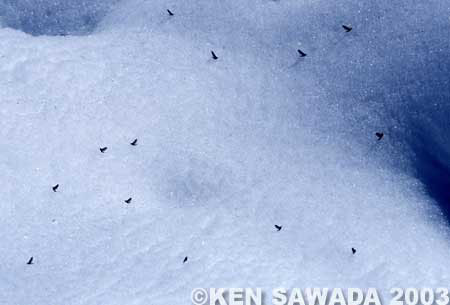
A lot of Olives flew down on the snow in the daytime.
I Want a Fly like a Sedge
Most of anglers, including me, usually headed upstream for two months until the snow melting water season was over and the whole river turned into a summer river. It was quite natural because we could enjoy summer fishing in the snow, which was one of the charms of the River Takahara.Here the fish responded very well to large flies even in early spring although those flies were usually used in high season. I looked for the best of them but could not find an ideal one from a thousand pattern list. There was no way but to produce on my own.
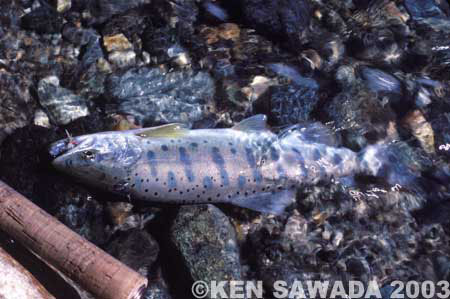
Spent Badger of size 16 performed very well in early spring.
I imagined a fly like a sedge, especially a long-barbelled giant sedge. It should be extraordinarily effective to the sedge-eating fish, particularly the big ones. It should be effective under the various situations. Describing in exaggerated terms, my ideal fly could catch the fish even when sedges were not flying or pupae were not swimming.
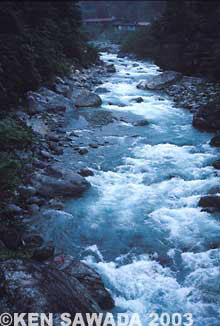
The scenery upstream from Yarimi Bridge. Warm and clear water was flowing even in winter.
I wanted to make a general fly, not a local fly only effective to the limited areas or under the limited situations. A general fly was expected to be available in a variety of sizes. Although materials sometimes limit the fly size, that must be avoided here.
The most difficult problem in making the ideal sedge-like fly was what material to choose for wings. Are there any good wing materials whose patterns make fish imagine the fly as a real sedge at the first glance and also which are more beautiful and brilliant than the real sedge wings? I looked back to my fishing of brown trout in the River Oshino more than 10 years before. All I had thought of there was the fly superior to the real sedge.
I had firstly searched for sedge-like flies with wings made of turkey and tried to use those made of various patterned turkey.
Then I was interested in peacock. In those days there had been only a few of ready-made flies with peacock wings. So I had to make by myself. I made a series of those flies, including Peacock Queen.
Then I wondered whether I could get more flexible and fine-patterned materials. What crossed my mind were the tail feathers of pheasant called Speckled Pheasant. Although I had used it for the wings of dry flies since I knew the material several years before, I felt that something had been wrong. I thought that the material might be more suitable to the sedge pattern of wet fly. I took out the material after some years’ neglect. Somehow I was sure that it was what I had looked for. This must be an ideal material!
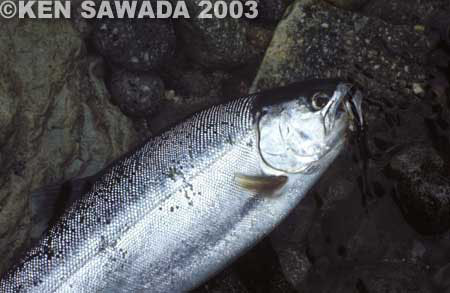
At the evening rise a yamame trout attacked Great Sedge.
Once wing material was found I had no hesitation. I had already decided the shape of my sedge fly: A tinsel body, protective-coloured body hackles, speckled flexible hackles and a short tail to make the fly posture stable. Immediately I completed the fly without any trials. At the first glance I was sure of its extraordinary ability. I named it Great Sedge without a moment’s hesitation. It was completed in spring of 1984, my third year of fishing at the upper reaches of the River Takahara.
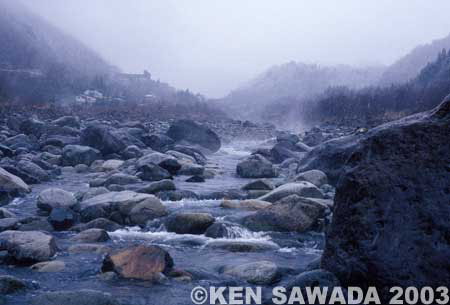
The snow was falling down at the upper reaches of Karukaya. But water was warm like hot water.
Great Sedge’s Debut
Several days after Great Sedge’s completion, probably in the middle of April, I went to the River Takahara with several new flies in the fly box. The deep-mountain area was covered with spring air and only a little snow remained on the bank.In the afternoon I fished upstream in Karukaya with dry fly, which lay at the upper reaches of Kansaka. There were a lot of large rocks on the steep banks and the water flowed most dynamically at the River Gamata, the name of the upper reaches of the River Takahara. However, the water of the Ashiarai valley, which flowed into the left bank near Chubu Technical College upstream, was not only cold but also full of limestone and dirty grey because it flew out of Mt. Yake in the Japan Alps. That made the water in Karukaya area not transparent.
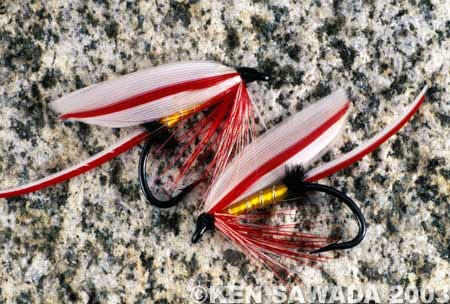
Parmachene Belle is the favourite bait of yamame trout although no angler believes before they use it.
I caught a middle-sized yamame trout and a char there. After 6 p.m. I headed upstream down Chubu Technical College. After passing the junction of the Ashiarai valley, the River Gamata (the River Takahara) looked completely different. The water became slightly greenish and so transparent that the bottom of the deep pool could be seen. The fish were very careful and only appeared in the dim of the evening or rainy days. That was completely different from the lower reaches of the Ashiarai valley, where the fish came up to the fly from non-transparent water even in the daytime.
The time was still suitable for dry fly fishing and usually I changed into wet fly a little later. But now I planned to fish upstream with my new wet fly from the first.
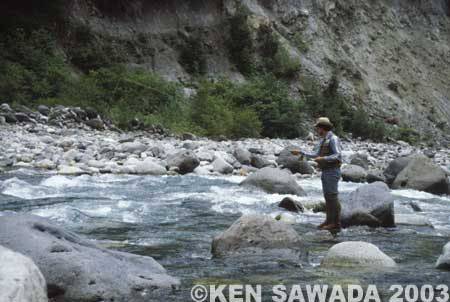
The lower reaches of Karukaya just after snow melting water season. Rich water and large stones brought up yamame trout.
My first choice was 3X leader of 7ft 6 inches, size 8 Parmachene Belle as a dropper and size 10 Great Sedge as a lead fly.
Changing the leader put to the flies, I headed upstream. I started fishing upstream, being careful not to cast the fly too many times even at the good point because I planned to fish the same point again on my way back. Fortunately at the first casting a fish bit the fly as soon as it settled on the surface. A middle-sized yamame trout was struggling under my feet, with Parmachene Belle as the dropper in its mouth. I can expect good response today!
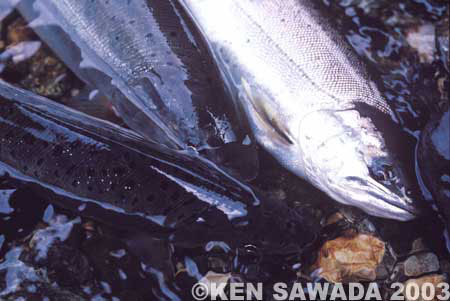
In the end of May most fish at the upper reaches grew up to be over 30cm.
It was really my golden day. Fishing upstream, I caught another 3 yamame trout of over 20cm. What surprised me was that all those 3 fish swallowed the lead fly. Usually the fish bite the dropper, which drifts ahead, like the first yamame trout. But this time those 3 fish bit Great Sedge as the lead fly. I felt something extraordinary in Great Sedge.
-- To be continued --
- NET SHOP INFORMATION
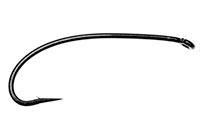
SL6 Black Spey Hooks
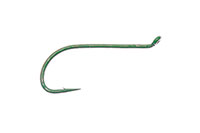
DU3 Limerick Spinner Hooks
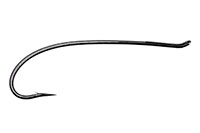
SL4 Single Bartleet Hooks
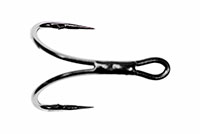
XD1 Tube Fly Double Hooks
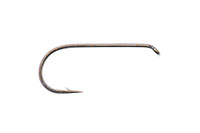
DD2 Flat Perfect Hooks
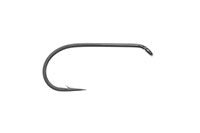
DD1 Black Terrestrial Hooks
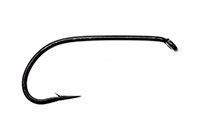
TD4 Old Limerick Wet Hooks
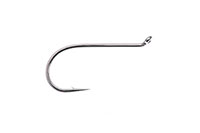
DU1 Silver May Hooks
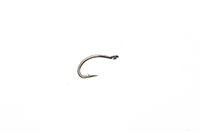
MU1 Flat Midge Hooks
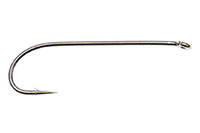
LD3 Long Limerick Hooks
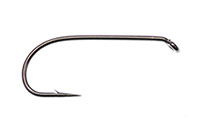
TD2 Summer Sproat Hooks
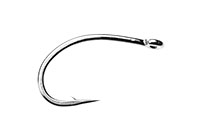
XS1 Tube Single Silver Hooks
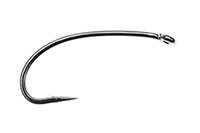
TD6 Siver Sedge Hooks

SL5 Black Spey Hooks

DU3 Limerick Spinner Hooks
- TROPHY CLUB
- FLY SHOW
- EXHIBITION
- MASTERS`
- FLY DRESSING CONTEST Archives
- TRAVELLER Archives
- TACKLE IMPRESSIONS Archives
- ANGLERS` PHOTO GALLERY Archives
- ----------------------------------------------
- トロフィークラブ
- フライショー
- エキシビション
- マスターズ
- フライドレッシング・コンテスト・アーカイヴ
- トラヴェラー・アーカイヴ
- タックル・インプレッション・アーカイヴ
- アングラーズ・フォトギャラリー・アーカイヴ
株式会社サワダ 185-0021 東京都国分寺市南町3-13-4
SAWADA'S INC. 3-13-4 Minamicho, Kokubunji, Tokyo 185-0021, Japan
写真・ドキュメントの無断転載を禁じます。
All the images and documents found on this site are owned by Ken Sawada and may not be used without permission.
But, link to this site is FREE.
Copyright © 2000 - 2025 SAWADA'S INC.. All rights reserved.
SAWADA'S INC. 3-13-4 Minamicho, Kokubunji, Tokyo 185-0021, Japan
写真・ドキュメントの無断転載を禁じます。
All the images and documents found on this site are owned by Ken Sawada and may not be used without permission.
But, link to this site is FREE.
Copyright © 2000 - 2025 SAWADA'S INC.. All rights reserved.
